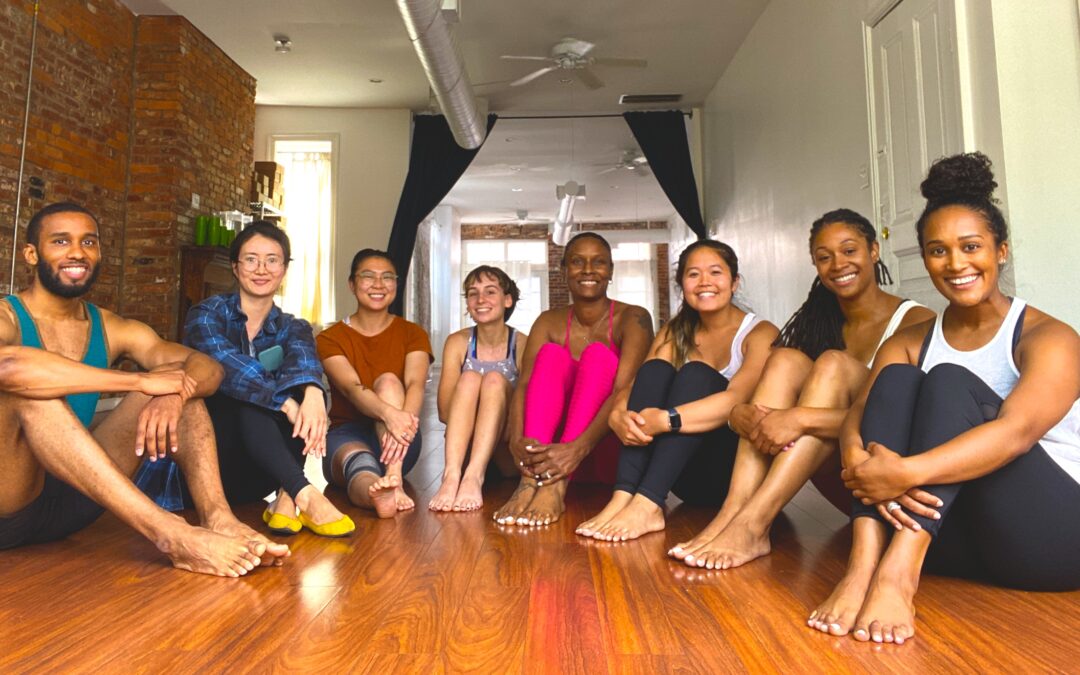Aaron, a Yoga District teacher trainee turned Yoga District instructor, recounts his experience during a Yoga District 200-hr Yoga Teacher Training (YTT) through a series of blog posts. He hopes it gives some insight into what happens in yoga teacher training and if it might be something you would want to try yourself. In this post, Aaron shares what it was like at the end of training to teach a yoga class to his fellow trainees.
the end of yoga teacher training
I’ve noticed over the course of training how happy I am sharing my passion for yoga with people and that I’d like to teach. So I did my best to treat the chance to teach my fellow trainees like it was real class.
Preparing to Teach
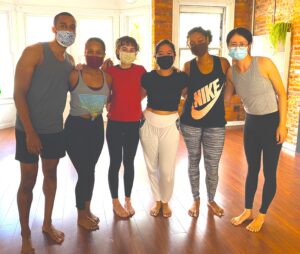 During training, I learned everything I needed to know:
During training, I learned everything I needed to know:
- How to introduce the type of class
- Create a class that includes the six basic movements of the spine
- Incorporate common sequencing patterns
- Beginning – gradually building intensity
- Middle – fluctuating between high-and-low intensity movements
- End – tapering it off before Shavasana (1)
Our teacher Blythe even showed us step-by-step how she sequences her classes. As a part of training, I also learned a lot by actively observing my teachers while taking their public classes. I took online and in-person classes by teachers like Andrea, Aparna, Camryn, and Emily. And in our Q&A sessions after the class, we got to understand what information helped guide them through some of the smaller aspects of their teaching style. Their choice of words to help students move safely into a posture. And the refinement cues they used to relieve discomfort and unnecessary tension in those students holding those postures.
I was excited when I got the chance to create my own class. I wanted to use what I had learned to create a Flow 2 class. Something physically demanding that builds heat and strength in the body. This class would have let me mix in all the fun sequences I’ve learned. But unfortunately, I didn’t have time to construct this type of class.
Time was my biggest challenge throughout yoga teacher training in general. I had to tackle 20 hours of training on top of my full-time job. Also, juggling all of that with my personal life and obligations outside of work. It placed a strain on my time like I’ve never experienced before. It was sometimes really hard.
One of the things that helped was our teacher Camryn openly acknowledging that YTT can be exhausting. And gave us the space as a class to talk about how we’re doing. She’d start her class by checking in with us. Letting us know it was okay to have these feelings. And this helped give me the encouragement I needed to press on.
That said, at my peak time constraint, I did have to reassess if I was still willing to invest my time in YTT. I asked myself:
- Do I still love yoga?
- Do I think I can make an impact as a teacher?
- Is this something I still enjoy?
My answer to all those questions was, yes.
From that reassessment I was better able to accept the challenge of YTT. I reminded myself it was a privilege. And I decided to make the most of the opportunity. I attempted to absorb as much information as I could from my teachers with the valuable time we had left.
Creating a Yin-Inspired Class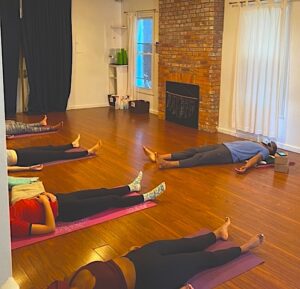
Understanding my time constraints also meant accepting that I didn’t have the time to create the kind of class I wanted to teach. And that that was okay. I could still do my best and teach something else. That’s how I decided on teaching a primarily Yin inspired class with a few flowy sequences in the middle (2).
I practice Yin regularly to help rehab from an injury. Teaching a class around it came naturally to me. There were fewer things to remember since postures are held for longer in Yin. Within a few hours I was able to:
- Find a Yin class online for inspiration
- Tailor it to create my own class
- Combine it with some flowy sequences to create a full Yin/Yang class
Due to a lack of time I had to adjust my approach to creating a music playlist for my class. In a more active class music can add an element of fun and light heartedness that’s hard to replicate with silence. Yet some yoga classes benefit from not having music, thereby allowing the mind to be aware of fewer things. Practitioners are then able to direct more attention to their breath and body. Although for my Yin class, I wanted to add a playlist. When holding postures for 3 to 5 minutes at a time, music can be soothing. While for some, it may pull some attention away from the breath and body. When done well, music can also be a useful tool to regulate a class’s mood and pacing.
A teacher’s playlist is also a way for them to imbue their class with a bit of their personality. I wanted to create a playlist that matched the mood of the different portions of my class with songs from artists that I love. Due to time constraints, I reached out to my training teacher Michelle to see if I could use something from her playlists. I enjoyed the music she uses for her Yin classes.
She was kind enough to share her public playlists. Using her Yin song libraries, I was able to curate my own playlist with the more relaxing songs intentionally placed towards the beginning and end during the yin portions of my class. More upbeat songs were situated in the middle of the playlist for the faster paced flowy part of class.
Teaching My Fellow Trainees
I had a lot of anticipation and anxiety built-up about teaching. I’m so used to being a student. Before yoga teacher training, I went into a yoga studio for five years as a student. During teacher training, there was always a teacher to instruct the class. And before when I had taught family and friends yoga classes, it somehow felt different. For the first time, I would actually be going to a yoga studio with the responsibility of teaching and instructing other people. 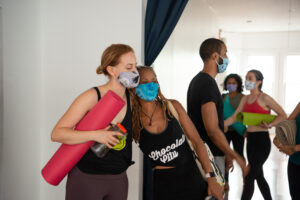
To help try and take some of the tension away, I did thirty minutes of intense cardio. As I went into 14th St. studio, I definitely felt that my nerves were more at ease. Still when it came time to teach, I was so nervous I could hardly talk. As my fellow trainees waited for me to start class, I could feel my heart rate pick up and had tension throughout my body. I managed to say the name of the class and cue a child’s pose (3).
Teaching My Class
I began my playlist as my students, my fellow trainees, got into the posture. I was more at ease. The students weren’t looking at me. I calmed my breathing and focused. I felt significantly more calm as I recognized I knew what to do..
Using an approach I had learned, from our teacher Jess, in YTT I asked the students to lift their left palm up to the sky if they would like to opt out of having any hands-on assists. Then I asked students to raise their right palm if they had any injuries that they would like to share with me. If they did, I would walk over and check in with them. One student shared with me that they had a tight shoulder. I thanked them for letting me know. And mentioned that we’d add some postures in class to help.
After a child’s pose, I cued them to table-top (4). And from there, we went through some basic wrist, ankle, and neck poses to help loosen the joints. Postures like toe bending (Padanguli Naman), wrist bending (Manibandha Naman), and neck movements (Greeva Sanchalana) (5, 6, 7). 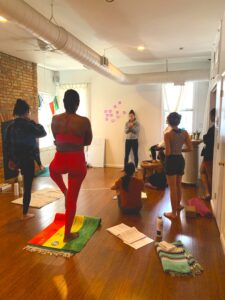
Next, I cued some side stretches from an easy pose (Sukhasana) (8). And then standard Yin postures like Butterfly (Baddha Konasana) and Pigeon (Eka Pada Rajakapotasana) (9, 10). The flow section followed with poses like Gate (Parighasana), Warrior III (Virabhadrasana III), and Figure Four (Eka Pada Utkatasana) (11, 12, 13). And finally wrapped up with some supine postures like Supine Pigeon (Supta Kapotasana) before finishing with Savasana (14).
In general, the poses I chose are ones that have been critical to my own physical rehabilitation. With a focus on releasing tension in the inner thigh and posterior chain. Areas the body can hold significant tension.
I sequenced the postures in an order that is anatomically safe. And, in a way that would hopefully feel natural for the body to move. For example, making the transition from wide-angle seated forward fold to butterfly only requires lifting the torso and bending the knees. These movements respect thet anatomy of the knee – a hinge joint that’s primarily meant to move back and forth. And lifting the torso up and bending the knees are movements a body is generally accustomed to doing multiple times a day.
However some of the transitions I chose, like moving from butterfly directly to pigeon, required a significant amount of flexibility and mobility in the hip. And based on the feedback from my teachers, I see now that it would’ve been nice to add a posture like table-top in between transitions like this in order to make the transition accessible for a wider range of students.
While teaching my class there were some hiccups. I completely forgot the name of a few of the body’s joints. My music was on shuffle play, which made it hard to know how far along I should be in the class since I couldn’t use the song as a cue. It was a bad idea to keep track in my head of how long to hold each yin posture so I cued some poses for the wrong amount of time. Despite these missteps, by the end of class I was completely fine knowing it wasn’t perfect. I just felt relieved I had managed to teach my first class.
Post Teaching Feedback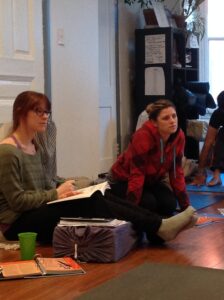
When I finished teaching the floor was opened for people to discuss what they thought about it. This type of feedback might seem embarrassing or tough to sit through. But as a YTT group we had built up so much respect with one another that I felt completely at ease. And was looking forward to the opportunity to get some honest feedback.
My classmates shared first and had mostly positive things to say. It was nice to know that I applied what I learned in YTT to create a yoga class that had a positive effect on my students. One person mentioned that they felt more relaxed after class. I learned from our training teachers Emily and Michelle in their Restorative and Yin class respectively how tone, word choice, and talking pace can help create a calming atmosphere.
My teachers had a lot of positive feedback but also some constructive recommendations too:
- Class Pacing
- My switch from yin, to flow, back to yin again felt a bit jarring.
- The pacing of the class would’ve been better to start with the flowy sequences at the beginning then move on to the Yin postures. Similar to a Yin/Yang class structure (15).
- Class Description
- My gentle flow class description was misleading since it didn’t align with the postures I offered in the middle of class.
- Particularly, how I cued transitions into poses like Side Lunge (Skandasana) and Figure Four (Eka Pada Utkatasana) at a fast pace (16, 17).
- My gentle flow class description was misleading since it didn’t align with the postures I offered in the middle of class.
- Creating a Caring Space
- They suggested that I create more of a sense of caring for my students during class.
- For example, getting off my mat and checking out student’s postures and offering customized refining cues.
I realized there are still things I need to refine in my teaching of a yoga class. Yet I was grateful that I got the chance to make these beginner mistakes in a supportive space with my classmates and teachers around. And that they were there to point them out so that I can work on improving them before I start teaching real classes.
Gratitude Circle
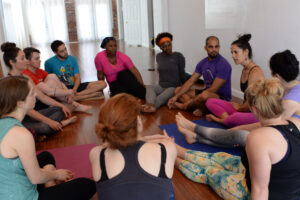
After each yoga class taught by one of my fellow trainees, we shared feedback with each other. Our last group activity of Yoga Teacher Training was a gratitude circle. Where each one of us said what we’re grateful for about one another. It’s hard to express the level of emotion. To sit in a circle with my YTT class after spending over two months sharing close space with one another exploring the physical and philosophical aspects of yoga. Knowing that our journey in training together was coming to a close.
When I looked around the circle, I thought back to how just a couple of months ago I didn’t know who they were. And now how their presence felt so familiar. How overwhelmingly blessed I was to be a part of such a diverse, kind, and supportive group of people. And when it was my turn to share, I did my best to express this sentiment with each one of them. How their individual traits like confidence, kindness, and faith have inspired me to be a better human. And my heart felt so loved to hear my classmates reciprocate similar sentiments with me.
Afterwards, we took some pictures and cleaned the studio one last time. Gradually each one of us walked down the studio’s steps out onto 14th street. I was one of the last to leave. A bit reluctant to exit the studio room that will forever be my yoga teacher training grounds. I eventually hugged my remaining classmates. Then biked home on what I thought was going to be a sad ride but I was at peace. My heart was full of love from all the kind words and compassion my teacher training family had shared with me.
What’s next
Juggling yoga teacher training on top of everyday life is hard. But I couldn’t be happier with my decision to finish training. Being able to push through that hardship gave me the confidence that I’m capable of doing more than I thought. It made me a stronger person. And by finishing training I’ve put myself one step closer to being able to share my passion for yoga with other people. In the next post I’ll be sharing what life is like after yoga teacher training.
Sources:
- Savasana, https://www.yogabasics.com/asana/corpse/
- Yin Yoga, https://yinyoga.com/
- Child’s Pose, https://www.yogabasics.com/asana/child/
- Table Top, https://www.yogabasics.com/asana/table-pose/
- Toe bending, https://himalayansages.com/blog/padanguli-naman-and-goolf-naman/
- Wrist bending, https://wellnesswithyoga.com/manibandha-naman-wrist-bending.html
- Neck movements, https://www.patientsengage.com/healthy-living/yoga-arthritis-greeva-sanchalana-neck-movement
- Sukhasana, https://www.yogabasics.com/asana/easy-pose/
- Butterfly Pose, https://www.yogabasics.com/asana/bound-angle/
- Pigeon Pose, https://www.yogabasics.com/asana/one-legged-king-pigeon-version-a/
- Gate Pose, https://www.verywellfit.com/gate-pose-parighasana-3567045
- Warrior III, https://www.yogabasics.com/asana/warrior-iii/
- Figure Four, https://www.pocketyoga.com/pose/figure_four
- Supine Pigeon, https://www.pocketyoga.com/pose/supine_pigeon
- Yin Yang Yoga, https://www.ekhartyoga.com/resources/styles/yin-yang-yoga
- Skandasana, https://www.pocketyoga.com/pose/side_lunge
- Eka Pada Utkatasana, https://www.yogapedia.com/definition/10987/eka-pada-utkatasana

